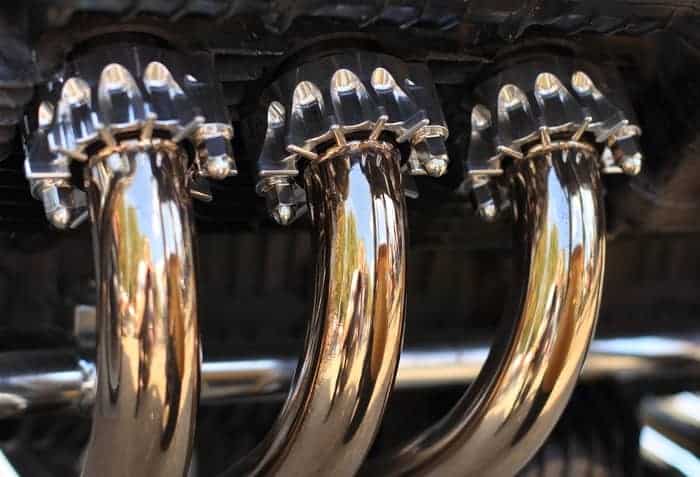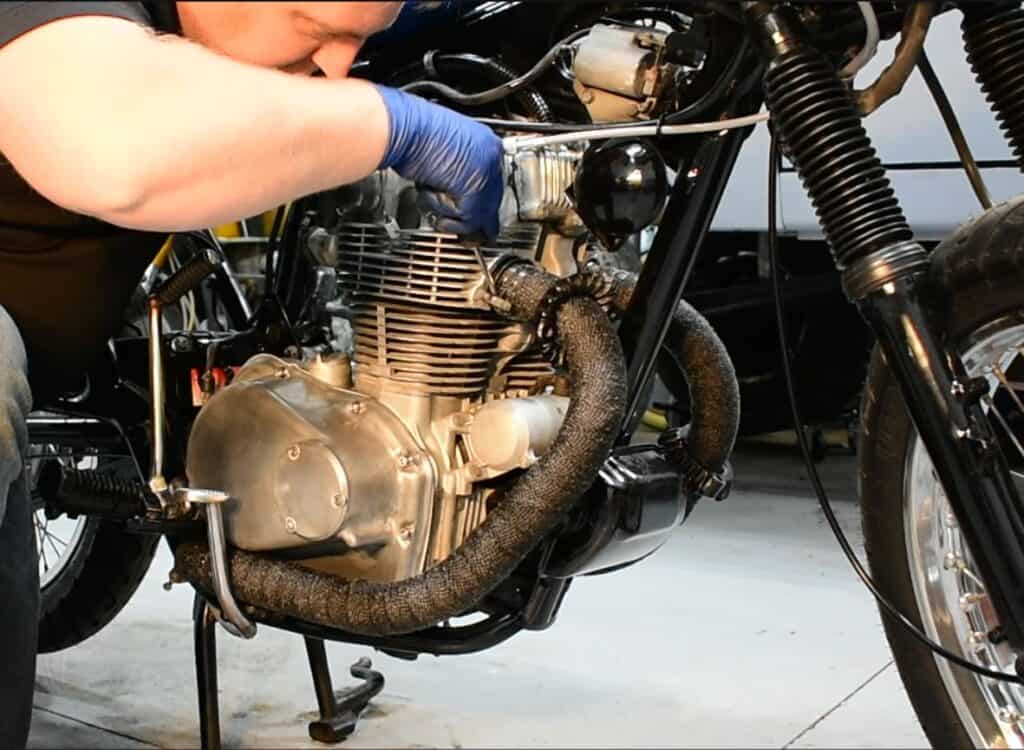
The exhaust on a motorcycle is a huge defining point of the bike itself. The way it looks and the way it sounds has a lot to do with the owner’s style and how they want to express themselves while out on a ride.
However the rider has their exhaust fashioned, every rider is susceptible to an exhaust leak. Exhaust leaks can be tricky to diagnose because it has to do with gases which are hard to see.
How can you tell if a motorcycle has an exhaust leak? The best ways to tell if a motorcycle has an exhaust leak is by first listening to any unusual popping sounds coming from the headers as well as a strong smell of exhaust. You can also try using soapy water or a light object like a paper towel and hover it over the exhaust to see if it flaps from a leak.
I personally am no stranger to exhaust leaks on my motorcycles. I’ve owned 13 of them and often ran into this issue. This article will explain exactly how you can diagnose an exhaust leak, how to fix it, and other information you’ll probably want to know.
Ways To Tell There Is An Exhaust Leak
Exhaust leaks on a motorcycle can sometimes be confused with other problems because of similar symptoms. If you suspect an exhaust leak on your motorcycle, it’s important to promptly take care of the issue to ensure it runs well and to ensure your personal health.
The best way to tell if you have a motorcycle exhaust leak is by the sound. Most exhaust leaks happen where the header connects to the engine. If you have a loose header, you’ll likely hear a popping sound. Sometimes this is mistaken for an engine going bad because an exhaust leak could sound similar to the valves tapping. A big leak will give a louder sound while a smaller leak will have a more subtle sound.
Sometimes hearing that popping sound isn’t enough to determine whether or not this is your issue. If you do hear a popping sound but aren’t sure if it’s the exhaust causing it, try turning on your motorcycle while it’s cold and listen to the characteristics of the popping sound. An exhaust leak will likely make a louder popping sound when it’s first turned on and subside as the engine gets warmer.
This is a sign of loose exhaust header bolts. Your gasket surface and your flange surface on the exhaust header aren’t fully touching when the motorcycle is first turned on. When it warms up, they expand and seal off the leak.
Another way to tell if you have an exhaust leak on your motorcycle is if the engine is on and you can sense a draft coming from the headers. I don’t recommend you use your hands since they can be extremely hot. Rather, use something light like a paper towel; hover it around the headers by the engine and see if you notice if the paper towel flaps from a leak draft.
You can also try spraying soapy water in the area you suspect the leak is. Be sure to do this when the motorcycle is off and cool; spray the soapy water, then turn on your motorcycle. Any spontaneous bubbling will indicate your leak’s location.
Also notice the smell of any exhaust while you’re idling on the motorcycle. There’s usually a small whiff of exhaust anytime you’re riding, but if you notice an excessive amount or you can smell it very strongly, that could also indicate an exhaust leak.
It’s not impossible to get an leak somewhere random on the exhaust header pipes though it’s much less likely than having a leak where the header connects to the engine.
Pin holes can form but it’s unlikely because water doesn’t stand much of a chance inside headers due to the constant heat going through them (unless your motorcycle has been sitting for a while). If you suspect a pinhole somewhere else on the header, you can use the same way to diagnose it using a paper towel or soapy water.
It’s more possible to have holes in the muffler. If holes have formed in the muffler, your exhaust will probably be a little louder (but different from the popping sound you may hear from the headers). This usually doesn’t cause much harm.
Causes Of A Motorcycle Exhaust Leak

Exhaust leaks are pretty common among motorcycles, especially older ones or ones that are heavily used by the rider. Knowing what causes the leak can really help in the future so you know how to best take care of your bike.
As it was mentioned before, the most common place for an exhaust leak to happen is between the connection of the header and the engine. Loose exhaust bolts is usually the reason it leaks because of the vibration of the engine during rides. So really, it’s more of a wear and tear issue.
If the leak isn’t due to a loose bolt, the second likely culprit is a faulty gasket. Not all motorcycles have a gasket between the header and the engine, but a lot do so it’s worth checking out how well it’s holding up if you’re having this issue.
Other leaks due to pin holes happen because of corrosion mostly from rust. This usually only happens if your motorcycle has sat for a while and have allowed rust to build up inside the exhaust system long enough to cause such corrosion. See our other article here to learn how to prevent exhaust rust on your motorcycle.
Is An Exhaust Leak Bad For My Motorcycle?
Once you find that a motorcycle exhaust leak is happening, you’ll need to take care of the issue as soon as possible. Many people wonder if an exhaust leak is bad for the motorcycle. Exhaust leaks aren’t good for the bike, which is why it needs to be addressed promptly.
Wherever the exhaust is leaking from, that piece of metal is going to get extremely hot because the heat is not distributing evenly. The pressure from the pistons is pushing out all of that hot air and instead of spreading out evenly throughout the header pipe and going out the end of the exhaust, a lot of it is going past one small hole. The heat from that will eat away at that metal real quick and can warp it.
The extreme heat can also cause the exhaust headers to turn colors, probably either yellow or blue. Though the color change is fixable, it’s annoying to deal with and is best to be avoided in the first place. See my other article here to learn more about why motorcycle exhaust pipes turn blue.
An exhaust leak on a motorcycle can also impact it’s performance. You won’t have as much power and you may notice your motorcycle acting slightly sluggish.
In a fluid dynamics sense, the exhaust leak is creating a discontinuity with the air flow. Any discontinuity in the air flow slows down the system altogether. This is because there are frictional losses; these losses are manifested through engine performance. In other words, an exhaust leak could cause the motorcycle to run slower depending on the severity of the leak.
It’s also bad for you as the rider if there is an exhaust leak on your motorcycle. There are noxious gases leaking right underneath you and can be very dangerous if you’re breathing those in. You’re essentially inhaling carbon monoxide; that’s why exhaust is routed to the back of the motorcycle away from the rider.
How To Fix It Yourself
Though this is an issue that should be addressed promptly, it’s actually a fix that most people can perform themselves and is inexpensive most of the time.
The first thing you should do when fixing this issue is address the tightness of the bolts connecting the headers to the engine. If they’re already tight, don’t over tighten them because doing so could cause damage to the engine (which would be an expensive to fix). Be sure to look up the torque specs in your manual to ensure those bolts are at the correct resistance.
If the torque specs on the header bolts are correct but you’re still having an exhaust leak, either the headers are placed in a little crooked, the gasket needs to be replaced, or the header itself may have warped so much that you need to get new ones.
Anytime you get a new header, make sure to also get a new gasket. Gaskets are usually very inexpensive and will ensure you’ve covered all your bases when making a fix like this.

